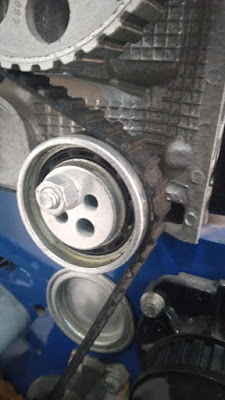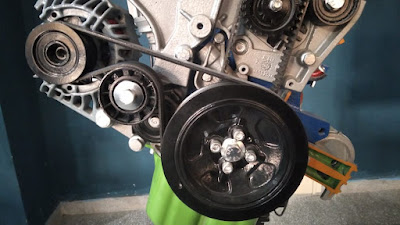Serpentine Belt vs Timing Belt ? what they do and how they are different. Both of these belts are an important part of an internal combustion engine. Each work closely with other engine parts to enable the smooth and perfect working of IC engines.
Timing belt and serpentine belt are so closely related that most people get confused and usually consider both the same. They are different in there work design, material, life, and importance.
Serpentine Belt vs Timing Belt
We have developed a comprehensive article on timing belt vs serpentine belt to make you comprehend the basic difference between serpentine belts and timing belts.
 |
| timing belt with timing belt tensioner |
Working of timing belt and serpentine belt
The belts are primarily designed to transfer power from one rotating part of a machine to another part that needs to be rotated. A timing belt is an important component of an internal combustion engine that connects the crankshaft with the camshaft to operate the exhaust and intake valves of the engine.
Movement of the crankshaft and camshaft must be well synchronized in an engine and the overall combustion quality, quantity of fuel being supplied for the combustion, and power output of an engine are strongly dependent upon the proper working of a timing belt.
Similarly, a serpentine belt is used to transfer power from the crankshaft to the other motor-driven parts of the engine such as power steering, alternator, water pump, air pump, and air conditioning system.
When the engine is turned on, the crankshaft pulley rotates the serpentine belt which in turn rotates all the engine components connected to it.
A properly working serpentine is quite important for the appropriate functioning of all the aforementioned components. The serpentine belt is also given different names such as alternator belt, fan, accessory drive belt, etc.
Design comparison for serpentine belt vs timing belt
Comparing the design in the serpentine belt vs the timing belt case makes it very clear how they are different from each other.
Several types of belts are used in an internal combustion engine that depends upon the type of engine and the amount of power to be transferred. The toothed side of the timing belt can have a trapezoidal, curvilinear, or modified curvilinear shape.
The shape or the design of the toothed side of the timing belt is usually selected after the estimation of the power that a bneedsneed totheetransferr. A few other important factors such as stress concentration, backlash, noise, etc. are also kept under consideration for the designing of a timing belt.
Furthermore, positive engagement between belt teeth and pulley groove teeth is achieved in the case of the timing belts to enable them to transfer higher torques and eliminate slippage.
Unlike a timing belt, a serpentine belt has multiple V-grooves that travel along the length of the belt. In actuality, serpentine belts are the updated version of V-belts and one can notice that old vehicles had multiple V-belts to operate alternators, air conditioning systems, power steering, etc.
A serpentine belt replaces multiple V-belts and is quite longer than a normal V-belt. It has an intertwining shape like a serpentine (snake) which helps the serpentine belt to achieve a high wrap angle and the appropriate amount of tension.
 |
| The serpentine belt on the IC engine with alternator and idler pulley |
Material of the belt
A timing belt is usually made of rubber but the material of a timing belt can vary from application to application. The selection of material is made based on different conditions such as temperature, amount of power to be transferred, and nature of the application.
Different materials are used in the making of timing belts such as rubber, polyurethane, and fabric. Timing belts made with rubber are quite common (especially in an internal combustion engine) and can be used in a variety of conditions.
Both natural and synthetic rubber have been used in the making of timing belts and neoprene (a synthetic rubber) has been a quite common material due to its ability to endure severe temperature changes and maintain its flexibility.
Serpentine belts are made of high-quality rubber. Neoprene rubber, a replacement for natural rubber, is the common material used in the making of serpentine belts.
Neoprene has been considered a durable and chemically stable material but there are a few disadvantages associated with them e.g. cracks, loss of flexibility at high tempetemperatures cetecreateakage, etc.
Ethylene Propylene Diene Monomer (EPDM) is another material that is preferred over neoprene in the making serpentine belt due to its longer life span and other associate advantages.
Working Life of each belt
It's important to consider working life for a comprehensive timing bet vs serpentine belt comparison. A timing belt like other parts of an engine has a specific working life and it will wear down with the engine mileage.
A low engine power, overheating or vibration in the engine, inability to start the engine and a tickling noise from the engine especially when the engine is cold are the timing belt symptoms that need replacement.
Although, an average-quality timing belt needs to be replaced after 60,000–100,000 miles. But it must also be noted that the working life of a timing belt may vary based on several other factors that can affect its life indirectly such as overheating, unexpected failure, and contact with leaked engine oil, etc.
The life span of a serpentine belt is dependent upon the material with which it has been made. Serpentine belts made up of neoprene can last a mileage of 50000 miles. Whereas a serpentine belt made from EPDM is considered a better alternative and can last up to 100000 miles.
Cost comparison for timing belt vs serpentine belt
The cost of a timing belt itself is not very high and a variety of timing belts are available in the market. The average price of a timing belt can vary between $15 and $50.
The cost of a serpentine belt is not very high and a serpentine belt made of neoprene costs between $10 and $30. Whereas the cost of the belt manufactured from good quality EPDM is around S20-S40.
Furthermore, the price offofrpentinbeltslt varies significantly with the change in the quality, type, and model of the vehicle.
Replacement cost of belt
Although, the price of a timing belt is not very high the replacement cost of a timing belt can be very high compared to its price.
This is because the timing belt is not easily reachable and a huge amount of disassembling and assembling is required to replace the timing belt.
Furthermore, a few other components that have a similar life span become easily reachable during the replacement process and it is not uncommon to replace them at the time of replacing the timing belt.
Furthermore, replacing timing belts in small engines is not costly but it can be more expensive in large engines. Hence, a total cost of around $250-$400 should be expected to get a timing belt replaced.
The replacement of a serpentine belt is not a very cumbersome and complex process. Nowadays, modern vehicles have idlers pulleys or tensioners which make the replacement process easier.
The replacement cost of the serpentine belt may vary with the model of the vehicle and location of the market etc. but the average cost can be around $50-$80.
What happens when the belt fails?
Taking the serpentine belt vs timing belt to next level, we will discuss whappensppen when each of these belts fails during driving.
As a timing belt is usually made of rubber so it will wear down throughout its usage and must be replaced within a suitable duration.
Its failure or breakage due to any reason will cause the engine to stop as its purpose is to synchronize the movement of inlet and exhaust valves that regularizes the process of combustion in the engine.
The breakage of the timing belt can also lead to complete engine failure or other untoward situations such as camshaft or cylinder head damage, cylinder wall damage, bent or broken valves, and piston damage.
Signs of an improperly working serpentine belt are a screeching noise from under the hood, the inability of power steering to perform its operation properly, overheating of the engine, and black smoke from the engine.
If a serpentine belt breaks down suddenly, the alternator will stop producing electrical power so headlights will turn dim, the battery will die, the power steering will get heavier, the air conditioner will stop working and the water pump will cease to circulate the coolant.
Therefore, a vehicle with a broken serpentine belt must not be driven for a longer distance as it can have unwanted and costly consequences.
Conclusion on Serpentine Belt vs Timing Belt
Based on the above comparison of serpentine belt vs timing belt we can conclude that each belt has its importance, working, and application. The serpentine belt cannot replace the timing belt and the timing belt cannot replace the serpentine belt.
No comments:
Post a Comment